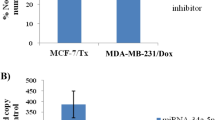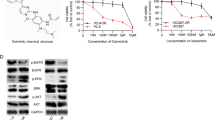Abstract
CD44, as a superficial cellular glycoprotein, is an essential factor in cell–cell and cell–matrix interaction. The CD44 expression level has been substantially up-regulated in breast cancer, and this upregulation facilitates tumor proliferation and angiogenesis. This study aims to evaluate the combination therapy of Jet Pei/CD44-specific-siRNA/doxorubicin in breast cancer MDA-MB468 cell line. The MTT assay, wound healing test, colony formation assay, DAPI staining, and flow cytometry were performed to investigate the tumoral cell viability, migration, clonogenesis, and apoptosis progression. The quantitative real-time PCR (qRT-PCR) was performed to demonstrate the CD44 expression level. Finally, the effect of CD44 silencing on the expression of VEGF, CXCR4, MMP9, and MiR-142-3p was measured. The combination of CD44-specific-siRNA with doxorubicin decreased tumoral metastasis, proliferation, invasion, and migration, and increased apoptosis in MDA-MB468 cells. In conclusions, CD44 can serve as a therapeutic target in breast cancer. Moreover, the combination therapy of CD44-specific-siRNA with doxorubicin can be a promising treatment for patients with breast cancer.





Similar content being viewed by others
References
Siegel RL, Miller KD, Jemal A (2016) Cancer statistics, 2016. Cancer J Clin 66(1):7–30
Martelotto LG, Ng CK, Piscuoglio S, Weigelt B, Reis-Filho JS (2014) Breast cancer intra-tumor heterogeneity. Breast Cancer Res 16(3):210
Vahidian F, Mohammadi H, Ali-Hasanzadeh M, Derakhshani A, Mostaan M, Hemmatzadeh M, Baradaran B (2019) MicroRNAs and breast cancer stem cells: potential role in breast cancer therapy. J Cell Physiol 234(4):3294–3306
Gupta GP, Massagué J (2006) Cancer metastasis: building a framework. Cell 127(4):679–695
Xu H, Tian Y, Yuan X, Liu Y, Wu H, Liu Q, Wu GS, Wu K (2016) Enrichment of CD44 in basal-type breast cancer correlates with EMT, cancer stem cell gene profile, and prognosis. OncoTargets Ther 9:431
Senbanjo LT, Chellaiah MA (2017) CD44: a multifunctional cell surface adhesion receptor is a regulator of progression and metastasis of cancer cells. Front Cell Dev Biol 5:18
Wang L, Zuo X, Xie K, Wei D (2018) The role of CD44 and cancer stem cells. Cancer stem cells. Springer, New York, pp 31–42
Yang ZF, Ho DW, Ng MN, Lau CK, Yu WC, Ngai P, Chu PW, Lam CT, Poon RT, Fan ST (2008) Significance of CD90 + cancer stem cells in human liver cancer. Cancer cell 13(2):153–166
Morath I, Hartmann T, Orian-Rousseau V (2016) CD44: more than a mere stem cell marker. Int J Biochem Cell Biol 81:166–173
Thapa R, Wilson GD (2016) The importance of CD44 as a stem cell biomarker and therapeutic target in cancer. Stem Cells Int. https://doi.org/10.1155/2016/2087204
Zhao S, Chen C, Chang K, Karnad A, Jagirdar J, Kumar AP, Freeman JW (2016) CD44 expression level and isoform contributes to pancreatic cancer cell plasticity, invasiveness, and response to therapy. Clin Cancer Res 22:5592–5604
Mani SA, Guo W, Liao M-J, Eaton EN, Ayyanan A, Zhou AY, Brooks M, Reinhard F, Zhang CC, Shipitsin M (2008) The epithelial-mesenchymal transition generates cells with properties of stem cells. Cell 133(4):704–715
Gao Y, Ruan B, Liu W, Wang J, Yang X, Zhang Z, Li X, Duan J, Zhang F, Ding R (2015) Knockdown of CD44 inhibits the invasion and metastasis of hepatocellular carcinoma both in vitro and in vivo by reversing epithelial-mesenchymal transition. Oncotarget 6(10):7828
Subramaniam V, Vincent IR, Gardner H, Chan E, Dhamko H, Jothy S (2007) CD44 regulates cell migration in human colon cancer cells via Lyn kinase and AKT phosphorylation. Exp Mol Pathol 83(2):207–215
Suri SS, Fenniri H, Singh B (2007) Nanotechnology-based drug delivery systems. J Occup Med Toxicol 2(1):16
Sledge GW, Mamounas EP, Hortobagyi GN, Burstein HJ, Goodwin PJ, Wolff AC (2014) Past, present, and future challenges in breast cancer treatment. J Clin Oncol 32(19):1979
Kachalaki S, Baradaran B, Majidi J, Yousefi M, Shanehbandi D, Mohammadinejad S, Mansoori B (2015) Reversal of chemoresistance with small interference RNA (siRNA) in etoposide resistant acute myeloid leukemia cells (HL-60). Biomed Pharmacother 75:100–104
Mansoori B, Mohammadi A, Shirjang S, Baghbani E, Baradaran B (2016) Micro RNA 34a and Let-7a expression in human breast cancers is associated with apoptotic expression genes. Asian Pac J Cancer Prev 17(4):1887–1890
Bhandare N, Narayana A (2014) Applications of nanotechnology in cancer: a literature review of imaging and treatment. J Nucl Med Radiat Ther 5(4):1–9
Kiyoi H (2012) Molecularly target therapy. Nihon rinsho Jpn J Clin Med 70:211
Pongcharoen P, Jinawath A, Tohtong R (2011) Silencing of CD44 by siRNA suppressed invasion, migration and adhesion to matrix, but not secretion of MMPs, of cholangiocarcinoma cells. Clin Exp Metastasis 28(8):827–839
Helmschrodt C, Höbel S, Schöniger S, Bauer A, Bonicelli J, Gringmuth M, Fietz SA, Aigner A, Richter A, Richter F (2017) Polyethylenimine nanoparticle-mediated siRNA delivery to reduce α-Synuclein expression in a model of Parkinson’s disease. Mol Ther Nucleic Acids 9:57–68
Wu Y, Wang W, Chen Y, Huang K, Shuai X, Chen Q, Li X, Lian G (2010) The investigation of polymer-siRNA nanoparticle for gene therapy of gastric cancer in vitro. Int J Nanomed 5:129
Fedorov Y, Anderson EM, Birmingham A, Reynolds A, Karpilow J, Robinson K, Leake D, Marshall WS, Khvorova A (2006) Off-target effects by siRNA can induce toxic phenotype. Rna 12(7):1188–1196
Li C, Liu B, Wen Z, Li H (2008) Inhibition of CD44 expression by small interfering RNA to suppress the growth and metastasis of ovarian cancer cells in vitro and in vivo. Folia Biol (Praha) 54(6):180–186
Misra S, Hascall VC, De Giovanni C, Markwald RR, Ghatak S (2009) Delivery of CD44shRNA/nanoparticles within cancer cells: perturbation of hyaluronan/CD44v6 interactions and reduction in adenoma growth in Apc Min/+ mice. J Biol Chem 284(18):12432–12446
Hu B, Ma Y, Yang Y, Zhang L, Han H, Chen J (2018) CD44 promotes cell proliferation in non-small cell lung cancer. Oncol Lett 15(4):5627–5633
Orian-Rousseau V, Sleeman J (2014) CD44 is a multidomain signaling platform that integrates extracellular matrix cues with growth factor and cytokine signals. Adv Cancer Res 123:231–254
Dewan M, Ahmed S, Iwasaki Y, Ohba K, Toi M, Yamamoto N (2006) Stromal cell-derived factor-1 and CXCR4 receptor interaction in tumor growth and metastasis of breast cancer. Biomed Pharmacother 60(6):273–276
Fuchs K, Hippe A, Schmaus A, Homey B, Sleeman J, Orian-Rousseau V (2013) Opposing effects of high-and low-molecular weight hyaluronan on CXCL12-induced CXCR4 signaling depend on CD44. Cell Death Dis 4(10):e819–e819
Lapteva N, Yang A-G, Sanders DE, Strube RW, Chen S-Y (2005) CXCR4 knockdown by small interfering RNA abrogates breast tumor growth in vivo. Cancer Gene Ther 12(1):84
Smith MC, Luker KE, Garbow JR, Prior JL, Jackson E, Piwnica-Worms D, Luker GD (2004) CXCR4 regulates growth of both primary and metastatic breast cancer. Cancer Res 64(23):8604–8612
Orian-Rousseau V (2015) CD44 acts as a signaling platform controlling tumor progression and metastasis. Front Immunol 6:154
Berkman RA, Merrill MJ, Reinhold WC, Monacci WT, Saxena A, Clark WC, Robertson JT, Ali IU, Oldfield EH (1993) Expression of the vascular permeability factor/vascular endothelial growth factor gene in central nervous system neoplasms. J Clin Investig 91(1):153–159
Murphy JF, Lennon F, Steele C, Kelleher D, Fitzgerald D, Long AC (2005) Engagement of CD44 modulates cyclooxygenase induction, VEGF generation, and proliferation in human vascular endothelial cells. FASEB J 19(3):446–448
Yu Q, Stamenkovic I (1999) Localization of matrix metalloproteinase 9 to the cell surface provides a mechanism for CD44-mediated tumor invasion. Genes Dev 13(1):35–48
Gupta A, Cao W, Sadashivaiah K, Chen W, Schneider A, Chellaiah MA (2013) Promising noninvasive cellular phenotype in prostate cancer cells knockdown of matrix metalloproteinase 9. Sci World J. https://doi.org/10.1155/2013/493689
Wang L-X, Mou Q-J, Mao J, Tang L-Y, Tao Y-J, Li L-H (2013) Significance of MMP9 and BRMS1 in metastasis and invasion of breast cancer stem cells. Control and Automation (ICCA), 2013 10th IEEE International Conference on, 2013. IEEE, Hangzhou, pp 943–946
Troschel FM, Böhly N, Borrmann K, Braun T, Schwickert A, Kiesel L, Eich HT, Götte M, Greve B (2018) miR-142-3p attenuates breast cancer stem cell characteristics and decreases radioresistance in vitro. Tumor Biol 40(8):1010428318791887
Acknowledgements
This work was financially supported by a grant from the National Institute for Medical Research Development (NIMAD), Iran, and Tabriz University of Medical Sciences (Grant No. 58843), Tabriz, Iran.
Author information
Authors and Affiliations
Corresponding authors
Ethics declarations
Conflict of interest
The authors declare that they have no conflict of interest.
Ethical approval
This article does not contain any studies with human participants or animals performed by any of the authors. Ethical code: IR.TBZMED.REC.1396.806.
Additional information
Publisher’s Note
Springer Nature remains neutral with regard to jurisdictional claims in published maps and institutional affiliations.
Electronic supplementary material
Below is the link to the electronic supplementary material.
Rights and permissions
About this article
Cite this article
Vahidian, F., Safarzadeh, E., Mohammadi, A. et al. siRNA-mediated silencing of CD44 delivered by Jet Pei enhanced Doxorubicin chemo sensitivity and altered miRNA expression in human breast cancer cell line (MDA-MB468). Mol Biol Rep 47, 9541–9551 (2020). https://doi.org/10.1007/s11033-020-05952-z
Received:
Accepted:
Published:
Issue Date:
DOI: https://doi.org/10.1007/s11033-020-05952-z




